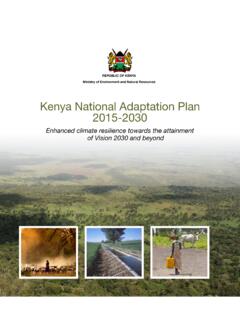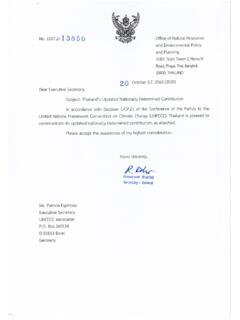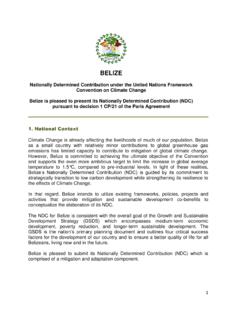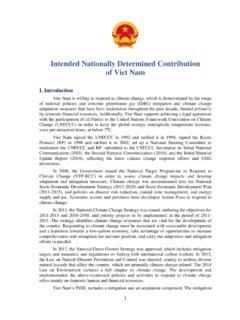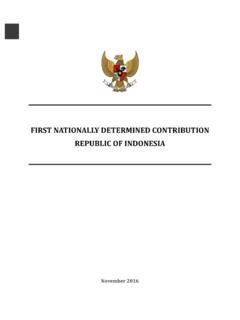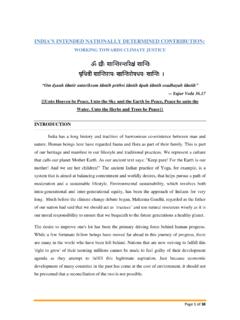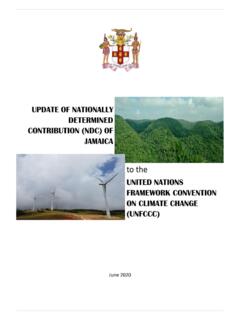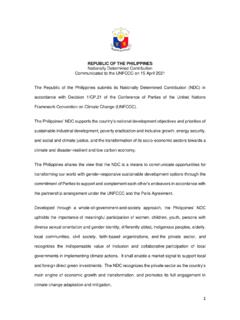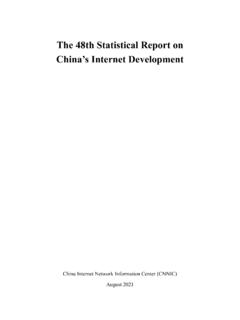Transcription of China’s Achievements, New Goals and New Measures for ...
1 (UNOFFICIAL TRANSLATION) China s Achievements, New Goals and New Measures for Nationally Determined Contributions1 1 This is an unofficial translation. In case of any divergence, the official text in the Chinese language shall prevail. i Contents INTRODUCTION .. 1 I. CHINA S PHILOSOPHY AND Goals ON ADDRESSING CLIMATE CHANGE .. 1 (I) China s Philosophy on Climate Change .. 1 (II) China s New Goals for NDCs .. 2 (III) Challenges Faced by China in Attaining the New Goals .. 2 II. POSITIVE RESULTS ACHIEVED IN THE NDC IMPLEMENTATION .. 4 (I) Continuous Improvement in Institutional System on Climate Change .. 5 1. Including climate change into economic and social development plans .. 5 2. Improving the systems and mechanisms on climate change .. 5 3. Establishing mechanisms for the decomposition and implementation of carbon emissions control targets .. 6 4. Making progress in carbon emissions trading market.
2 6 (II) Significant Progress in the Control of GHG emissions .. 8 1. Groping for new low-carbon development models .. 8 2. Initially building a low-carbon energy system .. 8 3. Expanding system of green and low-carbon industries .. 13 4. Promoting GHG emissions control from urban-rural development and construction area .. 16 5. Expediting the formation of low-carbon transportation system .. 18 6. Energy conservation and efficiency improvement led by public institutions .. 20 7. Increasing carbon sinks .. 20 (III) Proactive Adaptation to Climate Change .. 22 1. Issuing and implementing the National Strategy on Climate Change Adaptation .. 22 2. Taking actions on climate change adaptation in key areas .. 22 3. Advancing actions on climate change adaptation in key fields .. 24 4. Improving monitoring, early warning, and disaster prevention and mitigation capabilities .. 26 (IV) Initial Results Achieved in Supporting and Safeguard Systems.
3 26 1. Gradual establishment of GHG emissions statistical accounting system .. 26 2. Increasing funding and policy support .. 28 3. Growing technological support .. 29 4. Improving mechanisms for social participation .. 31 III. NEW Measures TO IMPLEMENT THE UPDATED NDC Goals .. 33 (I) Advance the Work on Carbon Peak and Carbon Neutrality in a coordinated and orderly manner .. 33 1. Boost the comprehensive green transition of socio-economic development .. 33 2. Deepen the action to peak CO2 emissions .. 34 3. Advance energy production and consumption revolution .. 34 4. Intensify the dual control of total energy consumption and energy intensity .. 34 5. Actively promote a green and low-carbon transformation of the industrial sector .. 35 6. Comprehensively promote green and low-carbon development in the urban rural construction .. 35 ii 7. Expedite the construction of green and low-carbon transportation system.
4 36 8. Press for emissions reduction and efficiency improvement in agriculture .. 36 9. Promote high-level environmental protection .. 37 10. Strengthen the market-based mechanisms including carbon trading .. 37 11. Launch demonstrations on carbon emission peak and carbon neutrality .. 38 12. Keep consolidating and increasing ecosystem carbon sinks .. 38 13. Effectively control non-CO2 GHG emissions .. 39 (II) New Policies and New Measures for Proactive Adaptation to Climate Change .. 40 1. Develop the Adaptation Strategy 2035 .. 40 2. Enhancement of resilience of natural ecosystems to the impacts of climate change .. 40 3. Enhance adaptability in the economic and social fields .. 40 4. Build a regional pattern of climate change adaptation .. 41 (III) Strengthen the Supporting and Safeguard Systems .. 41 IV. PROMOTING INTERNATIONAL COOPERATION ON CLIMATE CHANGE .. 43 (I) Construct a Equitable, Mutually Beneficial Global Climate Governance System.
5 43 (II) Positive Results in International Cooperation on Climate Change .. 44 (III) Further Expansion of International Cooperation .. 47 Annex I: Hong Kong Special Administrative Region s Climate Change Target and Progress .. 49 Annex II: Macao Special Administrative Region s Climate Change Target and Progress .. 53 1 INTRODUCTION Climate change is a grim challenge facing all mankind. Human activities since the industrial revolution, especially carbon dioxide (CO2) emissions from large-scale fossil fuel consumption of developed countries, have led to a drastic increase in the concentration of greenhouse gases (GHGs) in the atmosphere. As a result, global climate change has been aggravated, posing a huge threat to global ecosystem security and socio-economic development of developing countries. Man and nature form a community of life.
6 Addressing climate change is a common cause of the human race. It requires the international community to uphold multilateralism, pursue green and low-carbon development, and jointly build a community with a shared future for mankind. China is a developing country with a population up to billion. It is facing multiple challenges including economic development, people s livelihood improvement, and environmental protection, coupled with the prominent contradiction of unbalanced and inadequate development. China is also among countries most severely affected by climate change. Climate change has exerted persistent impacts on China s ecological environment and socio-economic development, and already brought serious threats to its food, water, ecology, energy, and urban operation security, as well as people s safety and property.
7 China attaches high importance to addressing climate change. As President Xi Jinping reiterated, to address climate change is not at others request but on China s own initiative. It is what China needs to do to achieve sustainable development at home, as well as to fulfill its due obligation to build a community with a shared future for mankind. China regards tackling climate change as an important starting point to push forward high-quality economic development, high-level environmental protection, and ecological civilization construction. It has incorporated climate change into the national economic and social development plans, put equal emphasis on mitigation and adaptation to climate change, and made every effort to advance all the work by legal, administrative, technical, market, and other means. In recent years, China has stepped up efforts to promote low-carbon development by effectively mitigating GHG emissions, proactively enhancing climate resilience, and continuously improving systems and mechanisms.
8 China has also played a constructive role in the finalizing of the Paris Agreement and its rapid entry into force, as well as in the negotiations on the rules for the full and thorough implementation of the Paris Agreement. Taking a driving seat in international cooperation to respond to climate change, China has become an important participant, contributor, and torchbearer in the global endeavor for ecological civilization. Earth is our shared home, as clearly put by President Xi Jinping, we must never relax our efforts to tackle climate change. The human race needs a self-revolution to accelerate the formation of green development patterns and lifestyles, with a view to an ecological civilization and a beautiful Earth. China will implement a proactive national strategy on climate change, promote and lead the establishment of a fair and equitable, mutually beneficial global climate governance system, and advance the construction of a community 2 with a shared future for mankind.
9 On September 22, 2020, President Xi Jinping declared, at the General Debate of the 75th Session of the United Nations General Assembly, that China would scale up its Nationally Determined Contributions (NDCs) by adopting more vigorous policies and Measures , and aims to have CO2 emissions peak before 2030 and achieve carbon neutrality before 2060. On December 12, 2020, President Xi Jinping announced some further commitments for 2030 at the Climate Ambition Summit: China will lower its CO2 emissions per unit of gross domestic product (GDP) by over 65% from the 2005 level, increase the share of non-fossil fuels in primary energy consumption to around 25%, increase the forest stock volume by 6 billion m3 from the 2005 level, and bring its total installed capacity of wind and solar power to over billion kW. On April 22, 2021, President Xi Jinping pointed out at the Leaders Summit on Climate that China has committed to move from carbon peak to carbon neutrality in a much shorter time span than what many developed countries might take, and that requires extraordinarily hard efforts from China.
10 The targets of carbon peak and carbon neutrality have been added to China s overall plan for ecological conservation. China is now making an action plan and is already taking strong nationwide actions toward carbon peak. Support is being given to peaking pioneers from localities, sectors and companies. China will strictly control coal-fired power generation projects, and strictly limit the increase in coal consumption over the 14th five - year plan (FYP) period and phase it down in the 15th FYP period. Moreover, China has decided to accept the Kigali Amendment to the Montreal Protocol and tighten regulations over non-carbon dioxide emissions. China s national carbon market will start trading. On September 21, 2021, at the General Debate of the 76th Session of the United Nations General Assembly, President Xi Jinping stated that China will strive to peak carbon dioxide emissions before 2030 and achieve carbon neutrality before 2060.
